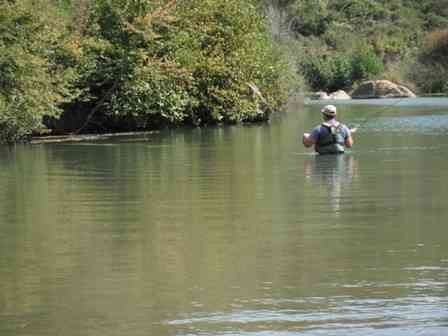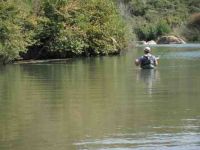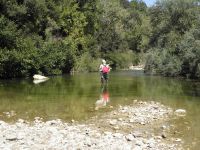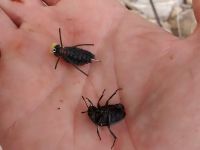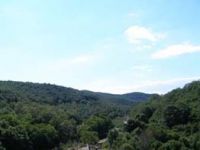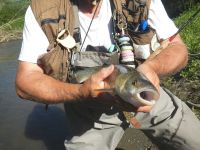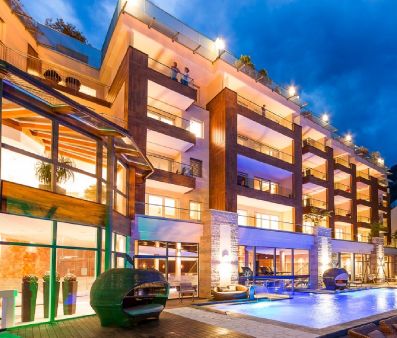The last house of the small village was some 20 minutes ago and we have driven through an uninhabited landscape following a rocky and sandy track. Huge holes in the asphalt – survived here and there as souvenir of old, better times – oblige us to zig-zag and proceed very slowly.
The mountain swallows us when we enter a long, dark and narrow tunnel at the end of which we are forced to protect the eyes from the bright sun.
We park the car a few meters from the ancient iron bridge, decades ago crossed by a local train. Today, the railways show the reddish color of time.
The blue ribbon of the river is some hundred meters below, and we can admire the reflection of the sun on the clear water searching its way across the boulders disseminated all along the river bed.
A small hill rests, motionless, on our left. Small round stones emerge from the short, yellowish grass. They’ve been rounded and levelled by the constant wind blowing through the valley. The eyes follow an unseen path carved in the tufa, now almost disappeared under the grass and reach the top of the hill, where a heap of stones and blocks of “peperino” indicate the presence of an ancient, primitive civilization, now disappeared but still alive in local people.
Everybody living in this province has, in his blood and soul, a hint of the ancient civilization of the Etruscans.
We are not far from the ruins of Luni, in the upper valley of river Mignone. We are in the middle of nowhere. We are where most of us would like to be once in a while. No computers. No portable phones. No shouting people. No bosses to tell you what to do. Only you and the old spirits of the Etruscans, half concealed beyond the ancient, ruined walls of the primitive village.
The river is some20 minutes’ walk from the car along a hardly visible path which descends the hill. It is not a difficult passage but being careful is a must.
Trekking boots would be perfect but the river suggests waders or, at least, hip boots, often necessary to cross some deep water passages.
The ladies won’t be with us: they have decided to stay up here and visit
the Etruscan ruins and tombs of this ancient village, known as Luni sul Mignone. They have their sacks with enough food and water for the day. They also have binoculars and camera: the wild nature of this land offers birds of prey, foxes, young deers, wild boars, colorful butterflies, horses, long-horned cows (known as “maremmane”)… a real treasure for those interested in ancient civilizations, wild nature and photography.
It’s mid morning and the sun is already high in the sky. It’s hot as it should be in this period of the year and as it must be for our fishing trip. Such a weather is of no use if you go for trout but here we don’t have salmonids.
The fishing technique in this kind of water is completely different from rocky mountain streams. The water is not very fast and creates big, sometimes deep pools holding savage, strong, shy chub.
Sometimes you see them from the distance, cruising a few inches under the surface, passing under overhanging vegetation or near the shore. Sometimes you don’t, but they spot you even if you are some 20 meters away.
This is not light and delicate fishing. The leader is some 2mt long, ending with a 0.20mm tippet. The best rod is an 8,5” or 9” equipped with a #6 or #7 flyline.
The fly is the imitation of a terrestrial, hook #8 or even #6. A hopper would be perfect. Or a small mouse.
A caterpillar. A wasp. Any would fit. Small poppers also give good results.
The first “must” for you is shelter: never stand up in good sight but crouch so that the fish can’t see you. Or use a big boulder, a bush, a tree as a screen between you and the fish.
The second “must” is detection and rapidity: find a cruising group of chub and cast – as quick as you can, keeping false casts to the minimum – the fly aiming to the tail (not the nose!) of the fish. Don’t worry if the fly creates sound or water movement. If you are concealed from the fish’ eyes, he will react abruptly, quickly and savagely. It reminds black bass fishing with a popper, but a little less rude.
Be ready for an immediate strike and a powerful fight. If you have decided to use barbless hooks (warmly recommended always and everywhere), after the strike keep pulling: the fish won’t escape.
At the end of the slope, we are some 15 meters from the river. Rods are ready and so we are. We approach the water slowly, avoiding stepping onto the unfixed pebbles and cast the fly near the group of roots emerging from the water. There is no fish in sight but some little, almost invisible movements of the water surface – do you remember bulging trout? – near a submerged root reveals a cruising finned presence… Don’t move. Don’t even whisper… you know that the fish can’t hear you but this is your unconscious reaction.
Again, the water surface is disturbed by the submerged presence. You step into the water. Big mistake! The waders boots hit the slippery pebbles and you grab the wading staff, in search of stability but the water you had stepped into sends thousandths of waves to the centre of the pool… to where your possible prey has taken shelter.
Your left hand squeezes the wading staff handle while the right one holds the rod, tip low to the water to avoid being seen by the fish. Stay motionless… don’t breathe…
A wake breaks the water surface from the root to the centre of the pool, some 20 meters away. Damn… it’s moving farther! You must move a little forward… quietly… slowly. The movements stop again but now you are within an easier casting distance. Stay still and wait.
A cloud runs over the bright sun and the water gets duller for a while and you don’t notice the shadow emerging from the depth and swimming slowly in circles around the root. Go and back. Go and back… go… and the fly darts in a blink, hitting the surface somewhere near the tail of the shadow.
A huge water ball explodes on the surface and you unconsciously pull the rod back, setting the hook. You’ve got the devil at the end of the line. And stop breathing.
It’s big. It’s strong. It’s a bastard. A really angry bastard aware of the fact that he’s been cheated and is fighting hard for his freedom. Chub are not as resistant as trout but can give serious problems if of good size: they pull, and swim fast around roots, and rub the nose against the bottom trying to get unhooked. You rely on the thick leader and “pump” the fish: he is not going to last for long and you know you can stress him using the rod’s spring action.
Soon, the heavy fish stops fighting but doesn’t surrender. He relies on his weight and reaches the bottom. You pull. He pulls. Once, Twice. Thrice… he’s tired, now. You bring him near your net, already mid-submerged and awaiting for the corpulent body.
He touches the net’s rim… a quick movement and returns back to the river bed. The operation is repeated two o three more times and, at last!, he enters the net while you lift your prey well above the water, lowering the tired right arm holding the rod.
A nice fish, indeed. We take a photo keeping him submerged so that he can breathe easily (he’s still in your net and can’t escape). It is really a nice fish. May I take another snap?
You run the risk to damage him... Please! It is my first big chub... Please...
Ok, let's make an exception. Hurry up... done? OK. A quick movement holding the fly between thumb and forefinger and he is free to swim away and rest under the root. This is the best prize for a good fighter.
For sure, the pool contains other “monsters” but more casts to the water will get no extra catches. Chub are very shy fish and the rest of the company has – we are convinced of this – left the battlefield and we would cast to an empty pool.
Reel in, get off the water and move a little upstream, aiming to the next pool, where other giants are waiting.
The hot air is filled with our words, explanation of the fight, description of the technique and gesticulation, repeating the whole action again and again.
We approach the next pool and from the distance we see the shadows of the fish cruising in the centre of the pool. We stay far from the water and get ready for an extra long shooting. More strikes will fill the rest of the day.
Butterflies go from flower to flower while some clouds appear at the horizon. The blue-greenish shapes of bee-eaters dart in the air… swallows almost touch the water surface in a quick dance… We are in peace with us and the rest of the world. Do we need more?
We still have 2 or 3 hours to spend immersed in this untouched nature. Waiting for the sunset and the “coup de soir” is of no use here, in this period of the year. We go back to the car following an easy cow track all along the river. The ladies reach us fifteen minutes later. Tired but happy: they, too, had a pleasant and interesting day.
A call to the "pizzeria" to book our table. A quick drive and we are already tasting "Margaritas" and "Diavolas" with an excellent local wine. When we leave the "pizzeria", billions of stars welcome us.
Note: best period for this stretch of river Mignone is during hot summer days and asks for good trekking skill.


